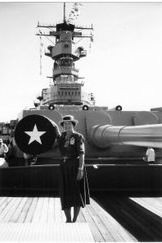Slave Labourer in Nagasaki – Part Two
About 11 o’clock the next morning the ship’s siren went off. One single plane with the markings of the Japanese flag came flying overhead. At 3 o’clock we saw a smoke plume on the horizon from a Japanese warship. Shortly afterwards another ship appeared, a corvette. They signaled for us to shop our ship. The two warships just kept circling, their two dozen or so torpedoes and their cannons pointing at us. Gabal and van Veen said: “Let’s go to the other side of the ship – then we can jump off if they start firing.” How naïve we were! When we were at the other side we saw more torpedoes and their cannons pointing at us, and the ships kept circling us like sharks. They lowered a sloop with a crew of marines who boarded our ship. Another three battle ships appeared on the horizon with double towers. Now we could see the enormous war power of the Japanese!
We felt humiliated and powerless with our insignificant gun. The Japanese officer made a speech in perfect English and told us that they would win the war and that we were now POWs without any honor. The Tjisarua started its engines again and we headed northeast to the Sunda Islands under escort of one war ship. Our red-white-and-blue flag was gone from the mast and instead there was the red circle.
Celebes
We entered the harbor of Macassar on the Island of Celebes (now Sulawesi). With a lot of screaming and pushing on the part of the Japanese guards, we disembarked. On shore we were counted, and counted and counted. Then came a loud “Kurrah” (hurry) and we had to jog. In the darkness of the night we finally were given the order to stop in front of a big ugly building which was formerly a women’s prison. We had to be counted again and again by a fierce Japanese guard who used a heavy piece of wood for counting. We were put in a cell that was made for eighteen women, and there were 130 of us! The ones at the walls had a little back support. The boys in the next cell had arrived one day earlier. We found out that they had survived the Battle of the Java Sea. We got the information through the prison walls by Morse code.
The next morning we had our first breakfast, a slice of bread. After that we had to wait till evening for a little rice and a piece of dried flying fish. Plates were not available and we had to use whatever we had – a hat, a handkerchief or our bare hands. The Japanese officers and ship’s crew came to watch us in our cells as if we were animals in a zoo. On one of these visits, one of the English survivors of the Battle of the Java Sea made a remark like “bloody bastards.” One of the officers who understood English overheard the remark. The culprit was taken out of the cell and fastened to a pole, with his hands above his head. Then he was beaten with a ship’s rope that had been soaked in water. This was the first of many tortures which I had to witness.
March 18 started as usual with counting, then breakfast, then counting again. Suddenly I heard commotions outside our window in the courtyard and heard a lot of “Kurrahs”. When I looked out, I saw a young eighteen-year-old Amboinese boy about to be shot by an officer of the guardhouse.
The Amboinese loved the Queen of Holland very much and in every one of their homes one could expect to find a portrait of Queen Wilhelmina hanging on the wall. The boy had been told to take down the picture of the Queen, which he did. The Japanese officer of the guardhouse threw the picture on the ground and started dancing on it, breaking the glass. He then tore the picture to shreds, whereupon the young Amboinese hit the Japanese officer in the face.
The officer took him to the courtyard behind the guardhouse and asked him if he would like to be blindfolded, but the boy refused. He was told that he would be shot, and they tied him to the pole. The officer walked backwards, took his pistol out and was ready to shoot. We watched with horror through the window. At that moment the boy managed to release one arm and he started to yell at the top of his lungs, “Long live the Queen!” The officer began shooting, and the boy kept yelling. After repeated shots the boy was still not dead; the officer walked over and put the gun to his temple.
Excerpt by John Franken. Published earlier in Four Years till Tomorrow
To be continued.
As always: I welcome your comments right here on this page.
Until next time,
Ronny

 Slave Labourer in Nagasaki
Slave Labourer in Nagasaki